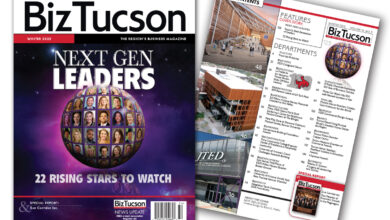
No. 10 Optics Valley
Creating Innovative Opportunity
11 REASONS THE WORLD IS WATCHING TUCSON
By Christy Krueger
In 1992, two events happened that had a monumental effect on Tucson’s emergence as an optics center. BusinessWeek magazine gave Tucson the name Optics Valley, and an organization called Arizona Optics Industry Association was founded as the first ever optics cluster.
Bob Breault, founder of Tucson optics company Breault Research Organization, became chairman of AOIA in 1992. After moving to Tucson from Silicon Valley, John Dennis joined the group in 2010. AOIA remained an independent optics cluster – an entity that represents the optics industry – until 2016. “Those of us on the board closed AOIA,” Dennis reported, “and moved the cluster activity to Arizona Technology Council.” There, the cluster became a committee, known as Optics Valley, and is co-chaired by Dennis and Jack Schumann.
According to Dennis, the committee’s mission is “to catalyze, convene and connect astronomy, optics and photonics-related businesses. We work with companies with programs, both virtual and in-person, and we support educational programs.”
Karla Morales looks at optics as an important part of the general technology sector. As VP of the Southern Arizona office of Arizona Technology Council, her responsibilities include overseeing membership and creating opportunities for workforce growth, including apprenticeship programs.
“We continue to see optics grow,” she said. “That’s why the world should be looking at Tucson. A lot of the work we do is international. People are looking at Tucson because we create innovative opportunities.”
Perhaps the most important portal to technology jobs in Tucson is through UArizona, where future talent is being trained by some of the best. The National Science Foundation ranked UArizona #1 in astronomy and astrophysics for the fiscal year 2020, with expenditures of $122 million.
Dean Tom Koch has been leading the College of Optical Sciences since 2012. He explained that the college has four theme areas: optical engineering, which involves designing specialized optics; fundamental optical physics; photonics; and image science. Astronomy is actually a separate department under Steward Observatory, he noted.
“Fundamental optical physics,” said Koch, is “understanding how light interacts with matter. Photonics is all the technology that makes the Internet work, semiconductors and fiber optics. Image science is used when you want to design a system for a specific purpose, such as in the medical field for task-based imaging and computational imaging.”
Career opportunities for graduates of UArizona optical sciences programs are promising. “Jobs are exploding,” Koch said. “Companies come to talk to faculty, and students present research and form relationships with companies before they even graduate. A field you would think of for jobs in optics is aerospace, but now there’s Facebook, Apple, Microsoft, Amazon – they all involve optics.”
An important project the James C. Wyant College of Optical Sciences is currently working on is Quantum Information Science and Engineering, which Koch explained as “all kinds of applications that connect quantum computers to become more powerful. We were appointed to lead the engineering research center to lay the foundation for the future of quantum Internet. It’ll change the landscape of the things we can do.”
He acknowledges that Tucson has a good reputation among the nation’s companies that may hire optics graduates or consider moving here. “We have good visibility and it creates interest for companies to invest in Tucson.” On a local level, he said most graduates are getting jobs with smaller companies. “But then there’s Raytheon – they hire a lot of our students.”
UArizona has frequently been named the largest optics education and research program in the country. “We have more faculty, research grants and contracts and more graduates,” Koch noted. “Most colleges and universities are supported by government agencies, such as National Institutes of Health and Department of Defense. We’re primarily supported by government, but a lot of our support is from private sector. With our research, we’re the first ones up to bat since others don’t know about it.”
One of the College of Optical Sciences’ big startup success stories is Nasser Peyghambarian, a faculty member who founded NP Photonics and moved to Tech Parks Arizona in 2000. NP (the founder’s initials) Photonics is an optics company and manufacturer of fiber lasers, fiber amplifiers and specialty fibers for sensing, defense, metrology and research markets.
Carol Stewart, associate VP for Tech Parks Arizona, said, “The College of Optical Sciences has world rankings. One of the premises of the university is optics. We concentrate on education of students and provide practical experience. The professors and researchers are working on projects ready to be commercialized and students get hands-on experience.”
She’s familiar with the numbers that illustrate the university’s significant impact on our state. “Optics brings a $2 billion impact to Arizona. Students who pursue degrees in optics have a great chance to get jobs here, and 43% of UArizona grads say they want to stay here. Quality jobs are the key to economic development anywhere. Optics salaries are very high, and optics brings business to Tucson and they hire employees. We’re moving forward in Southern Arizona. We have a lot of momentum right now.”





